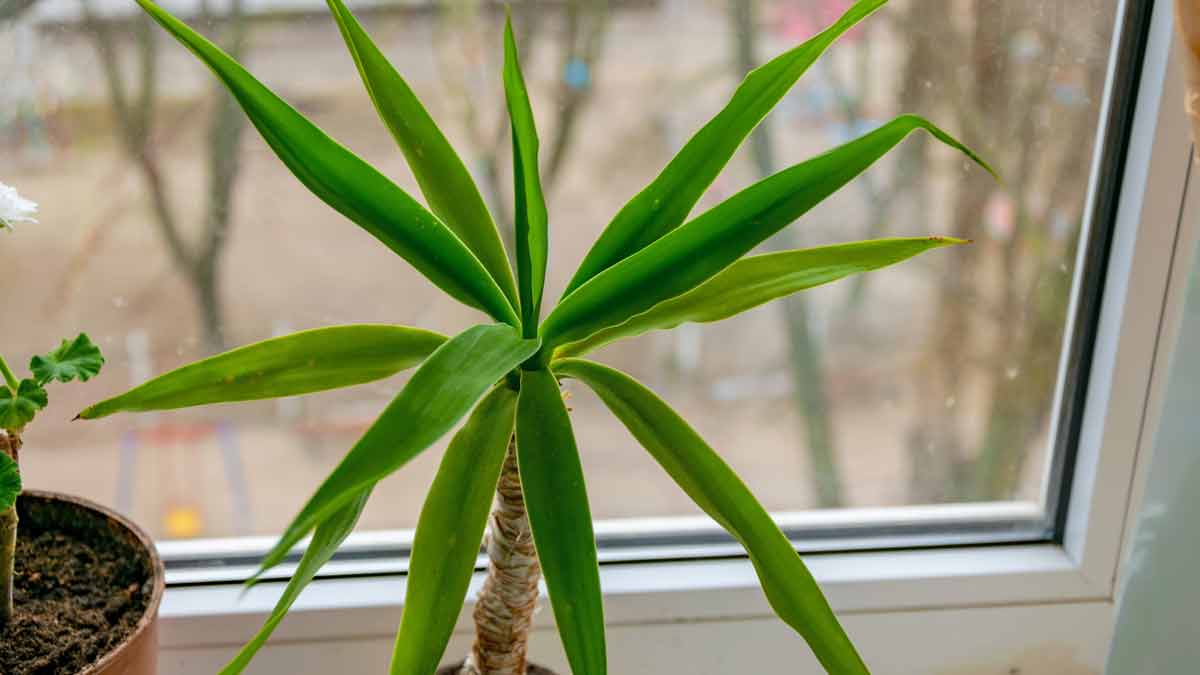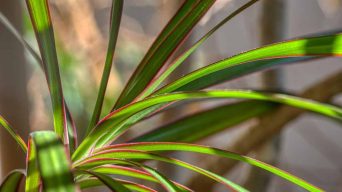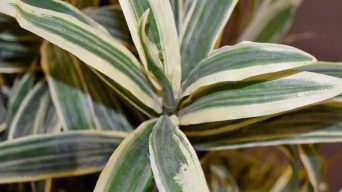White spots on Dracaena leaves may indicate a mealybug infestation or sucking pests that feed on plant tissue fluid. Powdery mildew is a fungal disease that appears as small white spots on plant leaves and flowers. To control mealybugs, use natural or chemical methods. Check the undersides of leaves for pests.
Often admired for their lush foliage and easy care routine, Dracaena plants sometimes face issues like mysterious white spots on their leaves.
While these blemishes can be caused by various factors such as pests, fungal infections, nutrient deficiencies, or environmental conditions, fear not as reliable solutions are within reach.
In this blog post, we’ll explore the five likely causes of white spots on dracaena leaves and offer practical remedies to restore your plant’s health and vibrancy.
Understanding The Causes Of White Spots On Dracaena Leaves
The vibrant green foliage of the dracaena plant is a sight to behold, but the appearance of unsightly white spots can be cause for concern.
A closer examination reveals a myriad of potential culprits – from pesky pests and harmful fungi to a lack of essential nutrients or even excessive exposure to sunlight.
Identifying the underlying cause is critical to restoring the plant’s health and vitality.
Pest Infestations
Pest infestations are a common cause of white spots on Dracaena leaves, and they can quickly wreak havoc on the health of your beloved plant.
The most prevalent pests affecting dracaenas are mealybugs, spider mites, and scale insects.
When dealing with these annoying pests, treating the affected areas and taking preventive measures to avoid future infestations is essential.
For example, wiping down your Dracaena’s leaves with a soapy water solution effectively removes both mealybugs and their eggs.
In cases where spider mite populations have become established, you may need to employ specialized miticides designed specifically for houseplants like dracaenas.
Fungal Infections
Fungal infections commonly cause white spots on dracaena leaves, with fusarium leaf spot being a prime culprit.
This contagious disease is characterized by the appearance of small, pale lesions that eventually develop into larger spots surrounded by yellow halos.
Over time, if left untreated, these spots continue to grow, leading to the yellowing and browning of leaves.
To combat fungal infections effectively, remove affected foliage to prevent further contamination of healthy green leaves.
Keep diseased plants away from other houseplants until they have fully recovered – this will help stop the spread of infection in your indoor plant collection.
You may also consider applying an appropriate fungicide treatment according to label instructions for added support against recurrent issues with fungi like fusarium or mildew.
Nutrient Deficiencies
Dracaena plants require a balanced diet of essential nutrients to maintain their vibrant foliage and overall health.
Nutrient deficiencies, such as a lack of nitrogen, phosphorus, or potassium, can lead to the appearance of white spots on dracaena leaves.
A common sign of nutrient deficiency includes yellowing leaf edges which gradually turn brown, while the center part becomes lighter with white spots.
To address these deficiencies and restore your dracaena plant’s health, test your potting soil for nutrient levels using a store-bought test kit.
Based on the results, you can choose an appropriate commercial fertilizer that provides essential nutrients for indoor plants like Dracaenas (e.g., a 20-20-20 formula).
Apply the fertilizer according to the package instructions every two months during active growth periods – usually spring and summer – while avoiding over-fertilization since it may cause further harm to your plant’s foliage.
Physical Damage
Physical damage is one of the common causes of white spots on dracaena leaves.
This can occur due to accidental hits or scratches from pets, kids, or furniture.
The good news is that physical damage can be fixed with proper care and maintenance.
First, trim the affected leaves using a clean and sharp pair of scissors or pruning shears.
Next, ensure your plant is well-hydrated by giving it enough water without overwatering it.
Moreover, when physical damage results from pests such as mealybugs or spider mites, you should treat the plant with insecticides specially formulated for indoor plants.
Sunburn
Sunburn is a common cause of crispy, localized brown spots on Dracaena leaves.
When the plant is exposed to direct sunlight for prolonged periods, its leaves may dry out and develop unsightly brown patches.
One way to avoid sun damage is by providing your Dracaena with filtered or indirect light.
Placing it near a window that receives bright but diffused light can help mitigate the risk of leaf scorch.
Additionally, consider using curtains or blinds to regulate the sunlight your plant receives daily.
How To Fix White Spots On Dracaena Leaves
In plant care, achieving optimal growth and health requires a delicate balance of factors.
From effective pest control to proper feeding and soil maintenance, each element plays a vital role in the well-being of your plants.
This is why it is essential to implement a holistic approach that considers all aspects of plant care, including fungal treatment, physical damage repair, and lighting adjustments.
This way, you can cultivate a thriving garden that flourishes with vitality and beauty.
Effective Pest Control
To fix white spots on your Dracaena leaves, it is important to have effective pest control measures in place. Here are some steps you can take to achieve this:
- Identify the exact pest that is causing the problem. Common pests that affect Dracaena plants include mealybugs, spider mites, and scale insects.
- Handpick any visible pests from the plant with a cotton swab or tissue. This works best for small infestations of mealybugs.
- For larger infestations, rinse the plant thoroughly with water and use insecticidal soap or neem oil as directed on the label.
- Quarantine any new plants before introducing them to your collection to prevent the spread of pests.
- Inspect your Dracaena plant regularly for signs of infestation and treat it as necessary.
By implementing these pest control measures, you can effectively manage and prevent future outbreaks of pests that cause white spots on your Dracaena leaves.
Fungal Treatment
One of the causes of white spots on Dracaena leaves is fungal infections.
Here are some effective fungal treatments:
- Trim affected leaves: Removing infected leaves can prevent the spread of the fungus.
- Apply fungicide: Follow the instructions on the label of a copper-based fungicide to treat and control fungal diseases.
- Adjust watering: Overwatering can lead to fungal growth, so it’s essential to ensure that your plant has proper drainage and you’re not watering too much.
- Improve air circulation: Fungi thrive in humid environments. Improving air circulation around your plant can help keep fungi at bay.
- Use neem oil: Applying a neem oil solution to infected plants can help reduce the severity of fungus growth as neem oil is antifungal and antimicrobial.
Remember that while treatment of fungal growth on Dracaena leaves is necessary, consistent monitoring and proper care practices will help prevent this issue from reoccurring!
Nutrient Management
Nutrient management is crucial to prevent white spots on your dracaena plant leaves.
Here are some tips for providing your plant with the nutrients it needs:
- Use a balanced fertilizer: Choose a fertilizer with equal or near-equal amounts of nitrogen, phosphorus, and potassium to provide your Dracaena with the necessary macronutrients.
- Add iron: If you notice yellowing leaves, this could indicate iron deficiency. Adding a chelated iron supplement can help correct this issue.
- Check soil pH: Dracaena plants prefer slightly acidic soil, so if your soil is too alkaline, it can reduce nutrient availability. Adjust soil pH by adding sulfur or acidifying fertilizers.
- Avoid overwatering: Overwatered plants can develop root rot, which inhibits nutrient uptake. Allow the soil to dry out partially between watering to prevent this issue.
- Choose the right potting mix: Use a well-draining, nutrient-rich potting mix that includes perlite or vermiculite to improve drainage and increase nutrient availability.
Repairing Physical Damage
Unfortunately, physical damage can sometimes be an issue with Dracaena plants, and it’s important to address this as soon as possible to prevent further problems.
If you notice any tears or holes in your plant’s leaves, trim any damaged areas with sharp scissors or pruning shears.
Another common cause of physical damage is overwatering.
When a plant gets too much water, the excess moisture can cause root rot, affecting the roots’ health and weakening the plant’s structure, making them more susceptible to tipping over and causing breakages.
It’s worth noting that repairing physical damage won’t necessarily fix white spots on Dracaena leaves directly.
Those issues require specific solutions (as discussed earlier) – so be sure to determine what’s causing these white spots before attempting any remedial action.
Proper Lighting
One of the major causes of white spots on Dracaena leaves is improper lighting.
If your plant isn’t receiving enough light or is exposed to direct sunlight for extended periods, it can lead to discoloration and white spots on the leaves.
It’s important to ensure that your plant receives adequate, indirect light to prevent this issue.
To ensure proper lighting, place your Dracaena where it will receive bright but filtered light, such as near a window with sheer curtains.
Avoid exposing it to intense afternoon sun, which can cause scorching of its leaves.
Also, consider rotating the plant periodically so that all sides receive equal amounts of light exposure.
Remember that different types of Dracaenas have varying lighting needs, so research what works best for your specific variety.
Preventing White Spots On Dracaena Leaves
As a lover of lush, vibrant houseplants, nothing is more disheartening than spotting white spots on the leaves of your beloved Dracaena.
Fortunately, this unsightly issue is easily preventable with the right care and maintenance.
You can keep your Dracaena healthy and looking its best by diligently practicing good hygiene, conducting regular inspections, and choosing the optimal location and lighting.
Regular Care
Regular care is one of the most essential preventive measures for keeping your Dracaena plants healthy and free from white spots.
Here are some tips for regular care:
- Water your plant regularly: Ensure you water your Dracaena plant regularly, but don’t overwater it, as this can lead to root rot.
- Provide sufficient humidity: Many Dracaena varieties prefer high humidity levels. You can create a humid environment by misting the leaves or placing a water tray near the plant.
- Clean the leaves: Dust and debris can accumulate on the leaves, blocking sunlight absorption and reducing air circulation. Wipe the leaves with a soft cloth or sponge to keep them clean.
- Provide adequate light: Most Dracaena varieties thrive in bright, indirect light. Make sure you place your plant near a window with plenty of natural light throughout the day.
- Fertilize occasionally: Feed your Dracaena with a balanced liquid fertilizer every few months during the growing season to keep it healthy and nourished.
Good Hygiene Practices
To prevent white spots on your Dracaena leaves, it’s crucial to follow good hygiene practices.
Regularly wiping down the leaves with a damp cloth or sponge can help remove dust and dirt that can attract pests and diseases.
In addition, avoiding overcrowding of plants is essential in preventing the spread of pests and diseases.
When new plants are introduced into your home, quarantining them for a few weeks before placing them near existing plants can help ensure they don’t bring any unwanted guests along with them.
Frequent Inspections
Regularly inspecting your Dracaena plant is crucial in preventing and fixing white spots on its leaves.
It’s recommended to check your plant’s leaves, stems, and soil at least once a week for any signs of pests or disease.
Look out for spider mites, mealybugs, and scale insects, which can cause leaf discoloration.
Also, pay attention to the color and texture of the foliage, as it could indicate potential problems with nutrients or watering habits.
Adjust your watering schedule accordingly if you notice brown tips or yellowing leaves.
Quarantining New Plants
If you’re a Dracaena owner, you must be cautious when bringing new plants into your home.
These new additions can often carry pests or diseases that could harm your existing plants.
When you purchase a new plant, keep it separate from your other plants for several weeks so that any potential issues have time to manifest.
Inspect it regularly during this period for signs of pests or disease.
If you notice anything suspicious, take action immediately before introducing the plant into your collection.
Choosing The Right Location
The location of your Dracaena plant can significantly affect its health and prevent white spots from forming on the leaves.
Choosing a spot with indirect or filtered light is essential, as direct sunlight can cause sunburn and lead to white spots on the leaves.
If you live in an area with low humidity, consider using a humidifier or placing a water tray near the plant to increase moisture levels.
Lastly, keeping Dracaena plants away from heating vents or air conditioning units is best since temperature fluctuations can harm these tropical plants.
Final Thoughts
Fixing white spots on dracaena leaves can be achieved by addressing the underlying causes of the issue.
Identifying whether it’s due to pests, fungal infections, environmental factors, or physical damage is important to implement the appropriate solution.
Effective pest control and fungal treatment are essential in ensuring a healthy plant, while nutrient management and proper lighting are also crucial to prevent the further development of white spots.
By taking preventative measures such as regular care and good hygiene practices, owners can help maintain their dracaena plants’ health for years.







